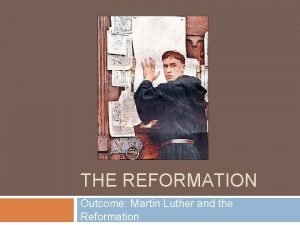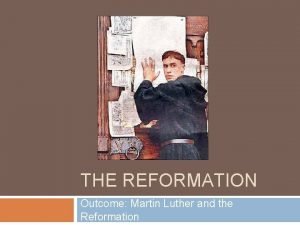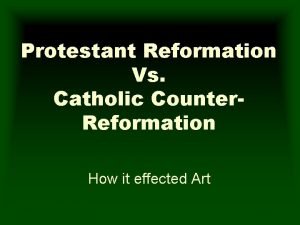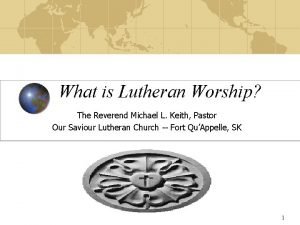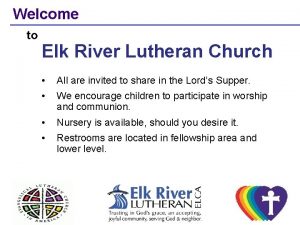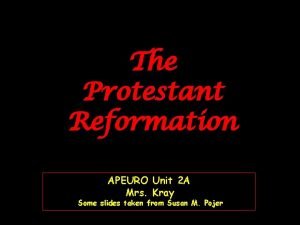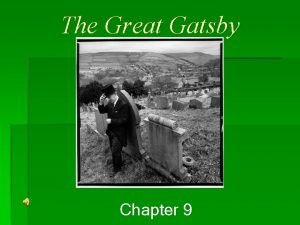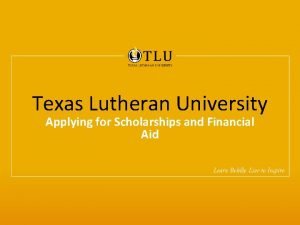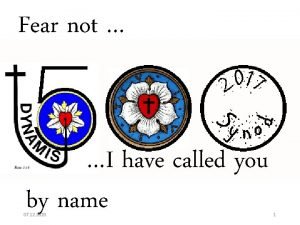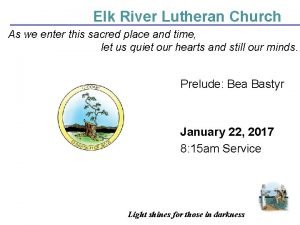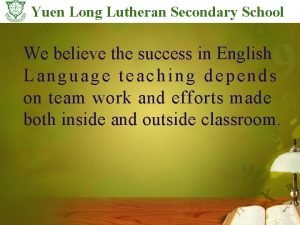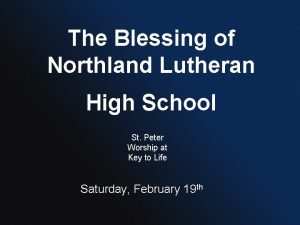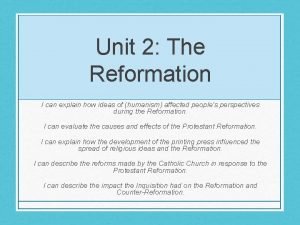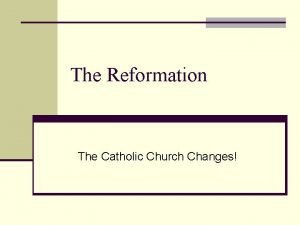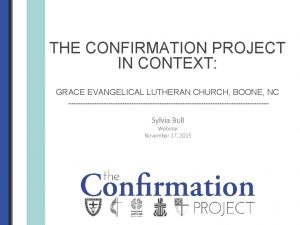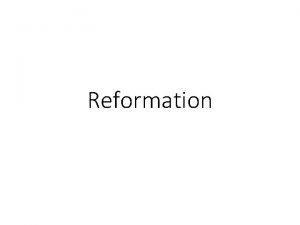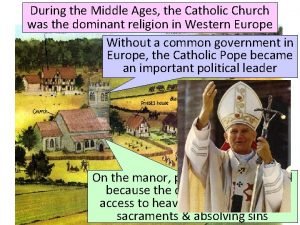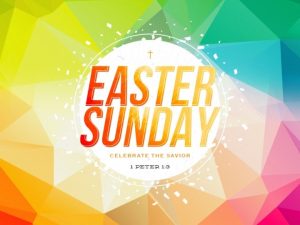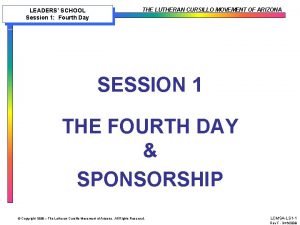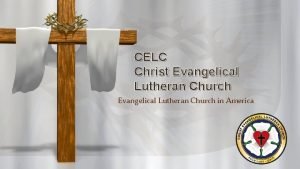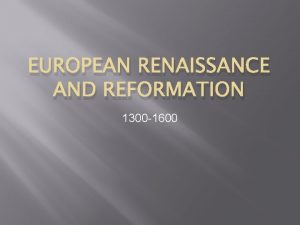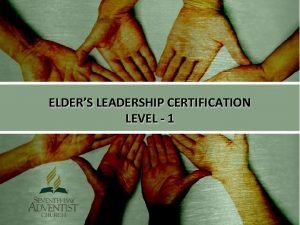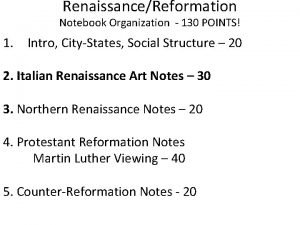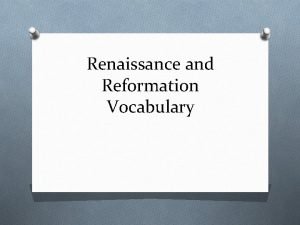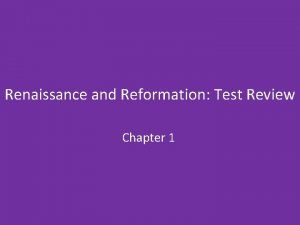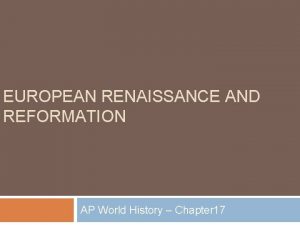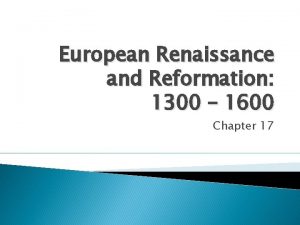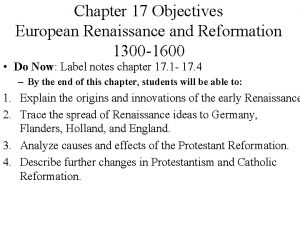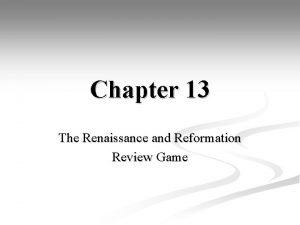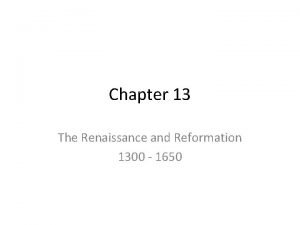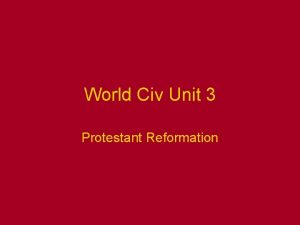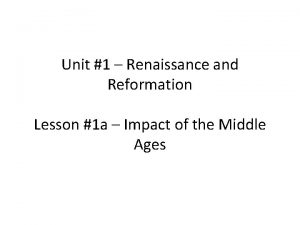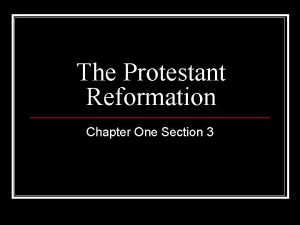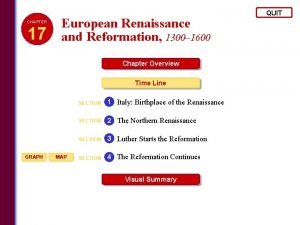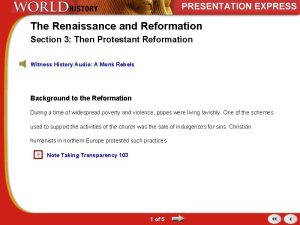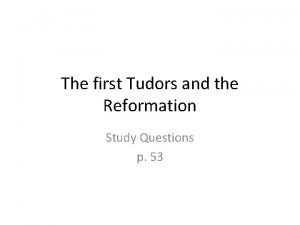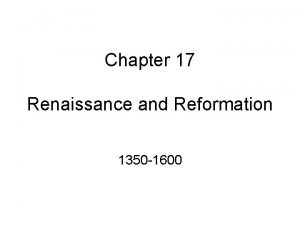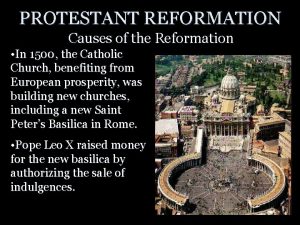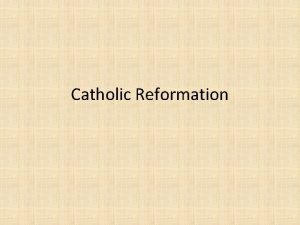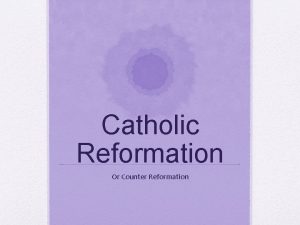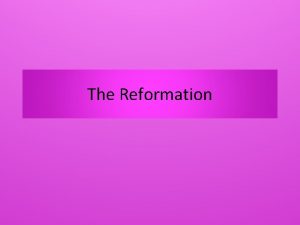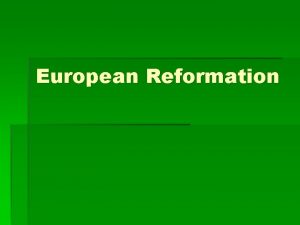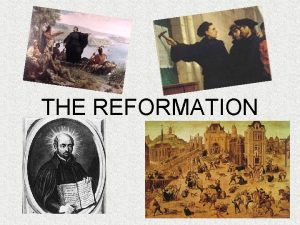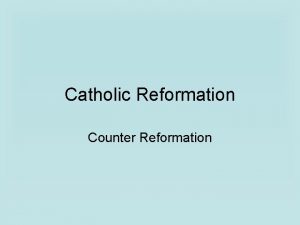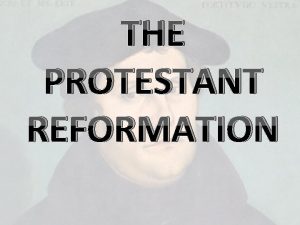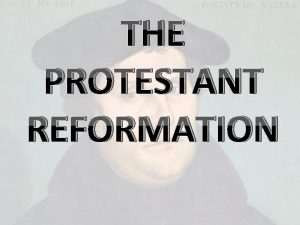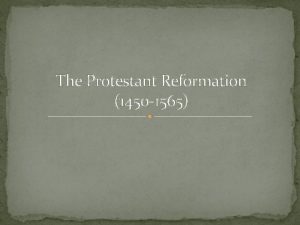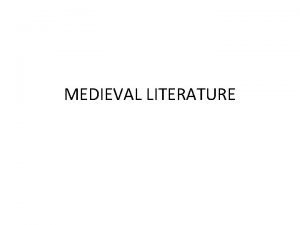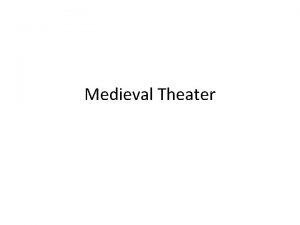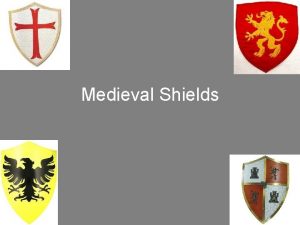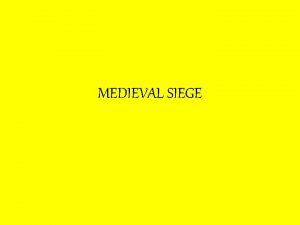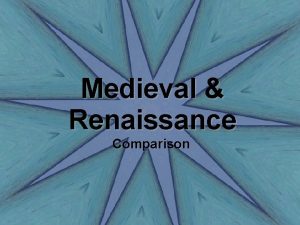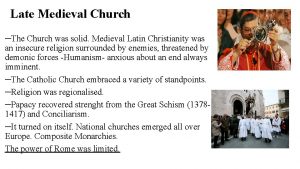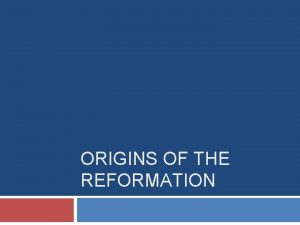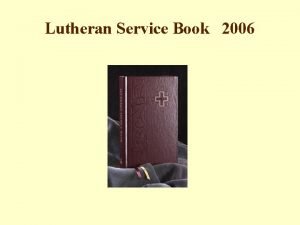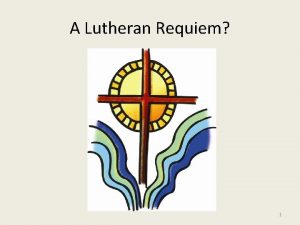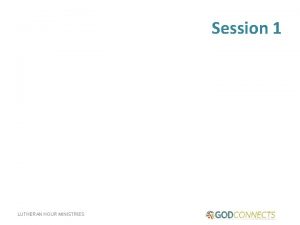Late Medieval Context and the Lutheran Reformation 1500




















































































- Slides: 84

Late Medieval Context and the Lutheran Reformation 1500 -1521

Two Pillars of the Late Medieval Church n Papal Primacy – Gregory VIII (1073 -1085) is the beginning of Papal Revolution. – Innocent III and Boniface VIII represent the height of Papal power. – Pope Pius II’s bull against Councils in 1460 is the pinnacle of that power. n Mass, Puragtory and Penance – The Mass is necessary for the forgiveness of sins and penance necessary before Mass. – Church buildings were adapted for a large number of altars (“chantry” from “cantaria”). – Belief in purgatory produced an industry of indulgences, masses, and prayers for the dead.

Sancto Spirito in Florence, Italy

Late Medieval Theology The Sacramental System n Grace, Merit and Works n – Via Antiqua (Thomas Aquinas) – Via Moderna (William Occam) – Augustinian (Gregory d’Rimini) n Practical Consequences: – Dependence on the institutional church – Anxiety and uncertainty § Negligence § Or, zealous activity



Late Medieval Piety n “The Devotio Moderna” – Geerte Groote (1340 -84), educated at Paris, entered monastery in 1374 but leaves in 1380 disillusioned. Stresses the imitation of Christ, faith and morality. Translated Scriptures. n “The Brethren of the Common Life” – Began as 12 disciples of Groote – Established various “houses” of influence (primarily in Netherlands and Germany). – Purity of life, study of Scripture, spiritual disciplines, shared resources, care for the poor, education for youth – Thomas a Kempis, The Imitation of Christ – Many Reformers were educated at Brethren schools: Erasmus, Bucer, and Calvin.

The Late Medieval Church n Institutional Abuses – Episcopal (Bishop) abuses § Absenteeism § Simony § Pluralism – Priestly abuses § § § n Greed Immorality Ignorance Papal Realities: – – – Claims vs. the Counciliar Movement Political Interests Rebuilding Rome’s Glory

Three Renaissance Popes Sixtus IV (1471 -84) – scholar, former head of the Franciscan order, he raised funds through heavy taxation and simony to finance the building of the Sistine Chapel. n The Sistine Chapel takes its name from Sixtus IV. n

Three Renaissance Popes Julius II (1503 -1513) – also known as the “Warrior Pope, ” was the patron of Michelangelo and financed the rebuilding of St. Peter’s Basilica. n Nephew of Sixtus IV n

Three “Renaissance” Popes Leo X (1513 -1521) – son of the banker Lorenzo de Medici of Florence, he had little interest in papal responsibilities and indulged his artistic loves as he invited Italy’s greatest artists to Rome.

St. Peter’s Basilica


Sistine Chapel n Built between 1475 -1483 by Sixtus IV, it was used as the Papal chapel and the place for the election of new Popes. n Some of the wall paintings were done by Botticelli. n The sky. ceiling was originally a star-studded


Sistine Chapel Ceiling n Pope Julius II asked for a few vines on a blue background on the 10, 000 square feet. n Over 340 human figures represented the origin and fall of humanity in Michaelangelo’s painting. n It took a little less than four years (1508 -1512) without assistance under adverse conditions by Michaelangelo.






Political Context n The Rise of Nationalism n Spain – Monarchs seek to centralize power – United the peninsula in 1492 § Established the Spanish Inquisition in 1480 § Expelled Jews in 1492 (165, 000 Jews left) § Expelled Muslims in 1502 – King Ferdinand of Aragon and Queen Isabella of Castile (married 1469) § Married daughter Joanna to Emperor Maximilian’s son Philip. – Charles I of Spain was their son (King in 1516) § Married daughter Catherine to Henry VII of England’s son Arthur (later married to Henry VIII).

Political Context n France – – – n Francis I reigned from 1515 -1547 Centralized authority in France and Spain fought four wars in first half of the 16 th century England – Henry VII (1485 -1509) began the Tudor dynasty. § Treaty with French in 1501. § Married sons to Catherine of Aragon § Married daughter Margaret to James IV of Scotland. – Henry VIII (1509 -1547)

Holy Roman Empire n Seven Individuals elected the Emperor (majority vote): – 3 Archbishops (Trier, Mainz and Cologne) – 4 Rulers (Duke of Saxony, Margrave of Brandenburg, Count Palatine of the Rhine, and King of Bohemia) Ruled Germany, Austria and scattered parts of Eastern Europe—the family Hapsburg had ruled as Emperor since 1273. n Emperor headed the Imperial Diet: n – House of electors, house of princes, and house of free cities. – The Empire was composed of almost 300 separate political units.

Maximilian I (1459 -1519) Married to Mary of Burgundy, daughter of Charles the Bold. n Elected Holy Roman Emperor in 1493. n Philip, the son of Maximilian and Mary, was married to Joanna, the daughter of Ferdinand Isabella, King and Queen of Spain. n

Holy Roman Empire in 1512

Hapsburg Family n Maximilian’s granddaughter Mary married Louis of Hungary-Bohemia and Louis’ sister (Anne) married Maximilian’s grandson Ferdinand. Mary and Ferdinand were children of Philip (Maximilan’s son) and Joanna of Castile. n The marriages arranged there brought Habsburg kingship over Hungary and Bohemia in 1526. Both Anne and Louis were adopted by Maximilian. n The Hapsburgs, then, by 1525 ruled the European world except Britain, France, parts of Italy and Poland.

Hapsburg Dynasty n Charles I, the grandson of Maximilian and King of Spain, was elected the Holy Roman Emperor as Charles V (1519 -1556). n The extent of his reign is reflected in his terse statement about his language range: “I speak Spanish to God, Italian to women, French to men, and German to my horse. ”


Hapsburg Empire n Charles’ brother, Ferdinand, reigned over the German regions of the Empire (as well as King of Hungary and Bohemia). Ultimately, Ferdinand would become Holy Roman Emperor in 1556 and Charles’ son Philip would become King of Spain and ruler of the low countries (Belgium, Netherlands) n Ferdinand continued the Hapsburg dynasty in Germany as well as Bohemia and Hungary along with parts of Italy.

Political Realities in Germany No centralized government; thus, territorial autonomy the norm. n Emperor is elected and dependent upon the respective parts of the empire. n Germany undergoing economic growth (Fugger banking) n No unity: n – – – 25 secular principalities 90 ecclesiastical principalities Castles of Independent Knights Free Cities Over 100 Counts

Holy Roman Empire in 1512

Italy and Eastern Europe n Italy: – Divided into five states § Duchy of Milan, Republic of Florence (Tuscany), Republic of Venice, Kingdom of Naples, and Papal States. – Italy was often subjugated by external powers as France and Spain fought over claims to title on the peninsula. n Eastern Europe – Contstantinople had fallen in 1453. – By 1500, Turks threatened Hungary, Bohemia and Austria. Turks already occupied Serbia and Bulgaria.

European Hostilities n Spanish-French Wars (Hapsburg-Valois Wars) n The Turkish Problem. n The Papal Problem – France continually invaded Italy to reclaim lands and assert rights in Naples from 1494 forward. – Spanish and Hapsburg rulers sided with the Italian states. – Charles V and Francois I of France fought four major wars from 1521 -1544 with Charles always on the winning side. – The Ottoman Turks defeated Louis of Bohemia and Hungary at the Battle of Mohacs in 1526 in which Louis died and Ferdinand (Charles’ brother) becomes King of Bohemia and Hungary. – The Turks besieged Vienna for 14 days in 1529 but retreated. – The Pope often joined with the French king because he was fearful of Charles’ power. – In 1527 Charles sacked Rome and by 1530 he controlled Italy.


Economic Context n The Black Plague (1350 s) – – – n Reduced population by 1/4 to 1/3. Introduction of monetary-based economics Rise in taxation, including Papal Significant Change in 1500 s – – Increased population (60 -85 million) Increased prices (greater demand) Increased trade (colonies) Consequently, an age favorable to bankers § Medici’s of Florence § Fuggers of Augsburg, Germany

“The Fuggerei” built by Jacob Fugger in Augsburg was the world’s first lowcost housing development. It is still in use today

Intellectual Context: Humanism n Renaissance Humanism (Italy, 1350 -1550) n Scholastic Humanism (Europe, 1450 -1650) n Reforming Humanism (Northern Europe, 14501550). – Renewal of classical art, architecture and ideas – – – Publication and study of ancient literature “Ad Fontes” (to the sources) Earliest surviving printed Scripture is 1457 (Psalms). – – – Reforming the Catholic institutions and power Reforming morals Many of the Reformers began as humanists (Zwingli, Calvin, Melanchton).

Erasmus (1466 -1536) “Prince of the Humanists” n Son of a Rotterdam priest, ordained 1492. – Educated by Brethren of Common Life – Studied at University of Paris as well as time in England Italy. – Lived most of his life in Basel, Switzerland n Important Work – Handbook of the Christian Knight (1503) – Praise of Folly – Editions of the Patristic writings – Editions of the Greek NT (1516, 1519, 1522, 1527).

Martin Luther (1483 -1546) n Complex Person: sought spiritual satisfaction, opposed church abuses, and never intended a church split. n Brilliant, gifted in language, passionate about his faith, but also anti-Jewish, rude/vulgar in language, and given to exaggeration.

Anti-clerical feelings in Germany n Resentment of German money going to Rome – papal taxes n Clergy not paying taxes n Perceived failure of clergy during Black Death n Resentment over large amount of land in Germany held by the church

Young Luther n Born in Eisleben, received M. A. at Erfurt in 1505. n Intended to study law, but due to religious experience he entered an Augustinian monastery in 1505. n Ordained a priest in 1507 and singled out by his mentor Staupitz to study theology for university teaching--received a Doctor of Theology in 1512. n Became the district supervisor of eleven monasteries, but ultimately began permanent teaching at the University of Wittenberg in 1512. – A new university begun in 1502 by Elector Frederick the Wise of Saxony

Trip to Rome 1510 n n n Sent to Rome to represent monastery Monks hoped holy city would encourage Repulsed by sale of relics, immorality Climbed stairs at St. John – did nothing Returned incensed by church corruption The Sacred Stairs at St. John Lateran

The Sancta Scala Constantine installed the stairs his mother brought back from Jerusalem at St. John Lateran. Supposedly the stairs at Pilate’s judgment hall in Jerusalem which Christ descended when beaten by the solders and ascended to return to Pilate for judgment Pilgrims say Hail Mary’s and Our Father’s going up the stairs on their knees.

Professor n As a monk and even more so as a Professor, he began to question the penitential system of the Catholic Church. n 1513 -1518 he lectured on biblical books at the University (Psalms, Romans, Galatians, Hebrews) and began to teach from the Greek text rather than the Latin. n His “conversion”: the meaning of the “righteousness of God” in Romans 1: 16 -17.

Indulgences n Pope Julius II announced a general indulgence to pay for the construction of St. Peter’ Basilica in 1510. n Pope Leo X extended the indulgences and appointed Luther’s Archbishop (Albert of Brandenburg) the high commissioner. n Albert was Luther’s Archbishop. John Tetzel was appointed a sub commissioner of indulgence sales.

The Indulgence Scandal n n n Albrecht von Hohenzollern sought the office of electoral Archbishop of Mainz from Pope Paid a high amount to secure it Loan financed by Fugger Bank Repaid through sale of indulgences John Tetzel (Dominican) put in charge

Reformer n 95 Theses in Latin: October 31, 1517 on the door of the Castle Church of Wittenberg. n He originally set forth several theses for academic debate at the University, but when they aroused little interest he directed these 95 theses at the sale of indulgences and the nature of repentance. n The door was the bulletin board of the University in Latin, but translated copies were published throughout Germany and Switzerland within months.

95 Theses n 1. Our Lord and Master Jesus Christ, when He said Poenitentiam agite, willed that the whole life of believers should be repentance. n 5. The pope does not intend to remit, and cannot remit any penalties other than those which he has imposed either by his own authority or by that of the Canons. n 21. Therefore those preachers of indulgences are in error, who say that by the pope's indulgences a man is freed from every penalty, and saved;

95 Theses n 27. They preach man who say that so soon as the penny jingles into the money-box, the soul flies out [of purgatory]. n 28. It is certain that when the penny jingles into the money-box, gain and avarice can be increased, but the result of the intercession of the Church is in the power of God alone. n 36. Every truly repentant Christian has a right to full remission of penalty and guilt, even without letters of pardon.

95 Theses n 45. Christians are to be taught that he who sees a man in need, and passes him by, and gives [his money] for pardons, purchases not the indulgences of the pope, but the indignation of God. n 52. The assurance of salvation by letters of pardon is vain, even though the commissary, nay, even though the pope himself, were to stake his soul upon it.

95 Theses n 82. Question: "Why does not the pope empty purgatory, for the sake of holy love and of the dire need of the souls that are there, if he redeems an infinite number of souls for the sake of miserable money with which to build a Church? The former reasons would be most just; the latter is most trivial. " n 86. Again: -- "Why does not the pope, whose wealth is to-day greater than the riches of the richest, build just this one church of St. Peter with his own money, rather than with the money of poor believers? "

Luther and the Pope n n n April 1518 – Heidelberg meeting with Augustinian and Dominican monks (Bucer attended). October 1518 – Luther was called to account at Augsburg by Cardinal Cajetan (reformist). 1519 – Luther debated the masterful theologian John Eck at Leipzig. 1520 – Papal bull condemned Luther’s writings and ordered them to be burned. January 1521 – Luther was excommunicated. April 1521 – Luther appeared before the Imperial Diet at Worms and Charles issued an Edict declaring anyone who helps Luther a criminal and subject to arrest.

This building, built and owned by Jacob Fugger, was the site of the 1518 debate between Martin Luther and Cardinal Cajetan

Debate with Eck at Leipzig 1519 n Opportunity to debate John Eck of Ingolstadt n Invitation to colleagues Philipp Melancthon and Andreas Karlstadt n Luther joined, took floor n Eck identified him with John Hus, “heretic” n Luther appealed to authority of Scripture Johann Eck

Luther’s 1520 Tracts n Using printing press, Luther published tracts about every other week, stirring up Germany against the pope and Catholic hierarchy: – On the Babylonian Captivity of the Church – On the Freedom of a Christian Prince – Address to the Christian Nobility n Books produced at Diet of Worms

Exsurge, Domine Burning of the Bull in Wittenberg

Diet of Worms Charles was elected as Charles V the Holy Roman Emperor in 1519, and Frederick the Wise (Luther’s ruler) was one of the electors. n Charles agreed to hear Luther at Worms (April 1521). n Luther’s statement is renowned: n “Unless I am convinced by the testimony of the Scriptures or by clear reason (for I do not trust in the pope or in councils alone, since it is well known that they have often erred and contradicted themselves), I am bound by the Scriptures I have quoted and my conscience is captive to the Word of God. I cannot and I will not retract anything, since it is neither safe nor right to go against conscience. I cannot do otherwise, here I stand, may God help me, amen. ”

Luther before the Diet of Worms, 1521

Exile at the Wartburg, 1522 n n Taken into protective custody by Frederick Lived in isolation at Wartburg castle “Knight George” Translated NT into German – Used Erasmus’ 1516 Greek New Testament text n Andreas Karlstadt turned reformation in Wittenberg into violent revolution Luther as “Knight George”

Luther translating the Bible at the Wartburg The Wartburg

Andreas Karlstadt n n n 1477 -1541 Educated in philosophy, law, theology Universities of Cologne, Erfurt, Wittenberg 1510 became professor & doctor of theology at Wittenberg Luther expelled him 1522 Later taught at Basel University


Katherine von Bora n Former nun n Married Luther n Good marriage n Six children n “My Katie”

Luther’s home in Wittenberg Monastery in Wittenberg that became home for Martin Luther and his wife Katherine, their children, and others they took care of.


Organization of Churches n n n n Religion of prince determined religion of people in Germany Prince served as “Notbischof” Visitation, committee to encourage discipline Pastors over churches Separation of church & state, but cooperation between two areas Communion in both kinds Liturgical Worship—Differed little from Roman Catholics Doctrine defined by Augsburg Confession

House in Eisleben where Luther died in 1546 St. Andreas Church in Eisleben where Luther preached his last sermon Feb. 16, 1546

Luther’s Theology n “Sola Scriptura”—Scripture is the final authority n “Sola Gratia”—God’s grace initiates salvation n “Sola Fidei”—Salvation is by faith alone, not human works. n Priesthood of All Believers. n Spread through the Printing Press.

Why the Reformation Succeeded n Late Medieval Piety was Vibrant n The Reformation Offered Spiritual Satisfaction: – – – – Pilgrimages, confessional manuals, prayer books Lay movements (e. g. , Brethren of the Common Life) Rise in the veneration of Mary and saints. There was a strong spiritual longing and searching. The burden of medieval piety was lifted. Spiritual anxiety about salvation was alleviated. The institutional church seemed too bound up with economic and political realities and thus many felt alienated.

Augsburg Confession, 1530 n n At the Diet of Speyer in 1526, Emperor sought to enforce the Diet of Worms. However, the princes asked for more time. At Diet of Speyer in 1529, the Emperor told the princes that they could seize no more church land. At that time the princes “protested” (and thus were called “Protestants”). In response, the Emperor demanded to know what they all believed. Princes asked Philip Melancthon to draw up a confession of their faith, which they all the north German princes signed.

Philipp Melancthon n Humanist Scholar of Augsburg Confessions, 1530 n Worked with Bucer for unity n Author

Augsburg Confession, 1530 n n n Melancthon drew up confession Presented to emperor and assembly of princes and theologians at bishop’s palace in Augsburg Most Protestant leaders were present Luther could not go due to emperor’s ban Became confession for Lutheran churches For the time, common confession of all Protestants (even Calvin signed it later as Melanchton, Bucer and Calvin worked for unity).

Bishop’s Palace in Augsburg was the site of the 1530 Augsburg Confession presentation. The tower in the background is the only original structure/

Augusburg Confession (1530) n On Original Sin (#2) Also they teach that since the fall of Adam all men begotten in the natural way are born with sin, that is, without the fear of God, without trust in God, and with concupiscence; and that this disease, or vice of origin, is truly sin, even now condemning and bringing eternal death upon those not born again through Baptism and the Holy Ghost.

Augusburg Confession (1530) n On Justification by Faith #4 Also they teach that men cannot be justified before God by their own strength, merits, or works, but are freely justified for Christ's sake, through faith, when they believe that they are received into favor, and that their sins are forgiven for Christ's sake, who, by His death, has made satisfaction for our sins. This faith God imputes for righteousness in His sight. Rom. 3 and 4.

Augsburg Confession (1530) n On New Obedience #6 Also they teach that this faith is bound to bring forth good fruits, and that it is necessary to do good works commanded by God, because of God's will, but that we should not rely on those works to merit justification before God. For remission of sins and justification is apprehended by faith,

Augsburg Confession (1530) n Of the Church #7 Also they teach that one holy Church is to continue forever. The Church is the congregation of saints, in which the Gospel is rightly taught and the Sacraments are rightly administered. And to the true unity of the Church it is enough to agree concerning the doctrine of the Gospel and the administration of the Sacraments. Nor is it necessary that human traditions, that is, rites or ceremonies, instituted by men, should be everywhere alike. As Paul says: One faith, one Baptism, one God and Father of all, etc. Eph. 4, 5. 6.

Augsburg Confession (1530) n Of Baptism #9 Of Baptism they teach that it is necessary to salvation, and that through Baptism is offered the grace of God, and that children are to be baptized who, being offered to God through Baptism are received into God's grace.

Augsburg Confession (1530) n On Repentance #12 Of Repentance they teach that for those who have fallen after Baptism there is remission of sins whenever they are converted and that the Church ought to impart absolution to those thus returning to repentance. Now, repentance consists properly of these two parts: One is contrition, that is, terrors smiting the conscience through the knowledge of sin; the other is faith, which is born of the Gospel, or of absolution, and believes that for Christ's sake, sins are forgiven, comforts the conscience, and delivers it from terrors. Then good works are bound to follow, which are the fruits of repentance.

Augsburg Confession (1530) n Of Ecclesiastical Practices, #15 Of Usages in the Church they teach that those ought to be observed which may be observed without sin, and which are profitable unto tranquility and good order in the Church, as particular holy-days, festivals, and the like. Nevertheless, concerning such things men are admonished that consciences are not to be burdened, as though such observance was necessary to salvation. They are admonished also that human traditions instituted to propitiate God, to merit grace, and to make satisfaction for sins, are opposed to the Gospel and the doctrine of faith. Wherefore vows and traditions concerning meats and days, etc. , instituted to merit grace and to make satisfaction for sins, are useless and contrary to the Gospel.

Augsburg Confession (1530) n Of Good Works, #20 Our teachers are falsely accused of forbidding good Works. For their published writings on the Ten Commandments, and others of like import, bear witness that they have taught to good purpose concerning all estates and duties of life, as to what estates of life and what works in every calling be pleasing to God. Concerning these things preachers heretofore taught but little, and urged only childish and needless works, as particular holy-days, particular fasts, brotherhoods, pilgrimages, services in honor of saints, the use of rosaries, monasticism, and such like. Since our adversaries have been admonished of these things, they are now unlearning them, and do not preach these unprofitable works.

Augsburg Confession (1530) n Worship of the Saints, #21 Of the Worship of Saints they teach that the memory of saints may be set before us, that we may follow their faith and good works, according to our calling, as the Emperor may follow the example of David in making war to drive away the Turk from his country; For both are kings. But the Scripture teaches not the invocation of saints or to ask help of saints, since it sets before us the one Christ as the Mediator, Propitiation, High Priest, and Intercessor. He is to be prayed to, and has promised that He will hear our prayer; and this worship He approves above all, to wit, that in all afflictions He be called upon, 1 John 2, 1: If any man sin, we have an Advocate with the Father.

 The reformation outcome martin luther and the reformation
The reformation outcome martin luther and the reformation The reformation outcome martin luther and the reformation
The reformation outcome martin luther and the reformation Protestants vs catholics
Protestants vs catholics Pragmatics examples
Pragmatics examples Nonagist
Nonagist High context vs low context culture ppt
High context vs low context culture ppt Contoh komunikasi high context dan low context
Contoh komunikasi high context dan low context What is lutheran
What is lutheran Elk river lutheran
Elk river lutheran Christian vs catholic
Christian vs catholic A little before three the lutheran minister
A little before three the lutheran minister Texas lutheran university scholarships
Texas lutheran university scholarships Lutheran church leadership structure
Lutheran church leadership structure Elk river lutheran church
Elk river lutheran church Tswyllss
Tswyllss Muhlenberg lutheran church
Muhlenberg lutheran church Northland lutheran high school
Northland lutheran high school Episcopal vs lutheran
Episcopal vs lutheran Bethany lutheran primary school
Bethany lutheran primary school Catholic vs lutheran
Catholic vs lutheran Lutheran vs catholic
Lutheran vs catholic Grace lutheran church boone nc
Grace lutheran church boone nc Lutheran vs catholic beliefs chart
Lutheran vs catholic beliefs chart Lutheran vs catholic beliefs chart
Lutheran vs catholic beliefs chart Celc lutheran
Celc lutheran Lutheran foundation of st louis
Lutheran foundation of st louis Trinity lutheran school joppa tuition
Trinity lutheran school joppa tuition Lutheran cursillo
Lutheran cursillo Regina lutheran home
Regina lutheran home Christ evangelical lutheran church
Christ evangelical lutheran church Christ evangelical lutheran church
Christ evangelical lutheran church Celc lutheran
Celc lutheran Christ evangelical lutheran church
Christ evangelical lutheran church Celc lutheran
Celc lutheran Celc lutheran
Celc lutheran America africa and europe before 1500
America africa and europe before 1500 Who wrote praise of folly
Who wrote praise of folly Revival and reformation
Revival and reformation Topic 4 the renaissance and reformation
Topic 4 the renaissance and reformation Renaissance and reformation interactive notebook
Renaissance and reformation interactive notebook Renaissance and reformation vocabulary
Renaissance and reformation vocabulary Renaissance and reformation test
Renaissance and reformation test European renaissance and reformation answer key
European renaissance and reformation answer key Chapter 17 european renaissance and reformation
Chapter 17 european renaissance and reformation European renaissance and reformation chapter 17
European renaissance and reformation chapter 17 Chapter 13 renaissance and reformation
Chapter 13 renaissance and reformation Chapter 13 the renaissance and reformation
Chapter 13 the renaissance and reformation Unit 3: martin luther & the protestant reformation
Unit 3: martin luther & the protestant reformation Unit 4 lesson 1 the renaissance
Unit 4 lesson 1 the renaissance Luther leads the reformation cause and effect
Luther leads the reformation cause and effect Give up one’s views or beliefs
Give up one’s views or beliefs European renaissance and reformation
European renaissance and reformation Chapter 12 renaissance and reformation worksheet answer key
Chapter 12 renaissance and reformation worksheet answer key The renaissance and reformation section 3 quiz
The renaissance and reformation section 3 quiz The first tudors and the reformation
The first tudors and the reformation Chapter 17 renaissance and reformation
Chapter 17 renaissance and reformation Hát kết hợp bộ gõ cơ thể
Hát kết hợp bộ gõ cơ thể Lp html
Lp html Bổ thể
Bổ thể Tỉ lệ cơ thể trẻ em
Tỉ lệ cơ thể trẻ em Voi kéo gỗ như thế nào
Voi kéo gỗ như thế nào Tư thế worm breton
Tư thế worm breton Chúa yêu trần thế alleluia
Chúa yêu trần thế alleluia Môn thể thao bắt đầu bằng chữ f
Môn thể thao bắt đầu bằng chữ f Thế nào là hệ số cao nhất
Thế nào là hệ số cao nhất Các châu lục và đại dương trên thế giới
Các châu lục và đại dương trên thế giới Công thức tính thế năng
Công thức tính thế năng Trời xanh đây là của chúng ta thể thơ
Trời xanh đây là của chúng ta thể thơ Mật thư anh em như thể tay chân
Mật thư anh em như thể tay chân 101012 bằng
101012 bằng Phản ứng thế ankan
Phản ứng thế ankan Các châu lục và đại dương trên thế giới
Các châu lục và đại dương trên thế giới Thơ thất ngôn tứ tuyệt đường luật
Thơ thất ngôn tứ tuyệt đường luật Quá trình desamine hóa có thể tạo ra
Quá trình desamine hóa có thể tạo ra Một số thể thơ truyền thống
Một số thể thơ truyền thống Cái miệng bé xinh thế chỉ nói điều hay thôi
Cái miệng bé xinh thế chỉ nói điều hay thôi Vẽ hình chiếu vuông góc của vật thể sau
Vẽ hình chiếu vuông góc của vật thể sau Thế nào là sự mỏi cơ
Thế nào là sự mỏi cơ đặc điểm cơ thể của người tối cổ
đặc điểm cơ thể của người tối cổ Thế nào là giọng cùng tên?
Thế nào là giọng cùng tên? Vẽ hình chiếu đứng bằng cạnh của vật thể
Vẽ hình chiếu đứng bằng cạnh của vật thể Fecboak
Fecboak Thẻ vin
Thẻ vin đại từ thay thế
đại từ thay thế điện thế nghỉ
điện thế nghỉ
